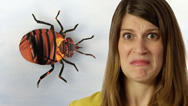How Far Do Germs Travel?
- By Anna Rothschild
- Posted 11.19.15
- NOVA
How far do coughs, sneezes, and vomit travel? Way farther than you might think. Find out how scientists track the germs that fly out of our faces in this episode of Gross Science.
Transcript
How Far Do Germs Travel?
Posted: November 19, 2015
How far do coughs, sneezes, and vomit travel? Way farther than you might think.
I’m Anna Rothschild, and this is Gross Science.
For decades, researchers have wondered exactly what happens to the liquids that fly out of our noses and mouths when we’re sick. But how do you track a tiny particle of phlegm or barf and the microbes they carry?
Well, back in the 1930s, Harvard scientist William Firth Wells gave it a shot. Wells used “sneeze powder” to make whole rooms full of people sneeze at once. Then he sampled the air and found it full of bacteria, though less so if he let his subjects use handkerchiefs.
These days, scientists can use high-speed cameras to see the juicy details of sneezes and coughs. That’s what researchers at MIT did in 2014. They found that the droplets in a cough or sneeze travel on an invisible gas cloud, which can carry germs much farther than people previously thought. Small droplets can fly all the way across a room, and can get sucked into ceiling air vents, which could spread them even further.
And that’s not all. To study what happens when someone’s really sick, scientists in the United Kingdom built a robot called Vomiting Larry, who’s basically just a head and stomach. The researchers were studying norovirus, which is a nasty bug that causes nausea, diarrhea, and projectile vomiting. To simulate the act of puking, they filled Larry’s gut with fluorescently dyed water. Then they made him retch it up.
The dye showed that Larry’s puke particles scattered farther than they would have been able to see with the naked eye. One projectile vomiting episode could actually contaminate close to eighty four square feet. That means viruses might linger in places we think are clean. And in the case of norovirus, those germs might stay active for days or weeks outside of a host.
Recently, in a study with a different vomiting machine—and, yes, there’s more than one—researchers at North Carolina State University found that some viral particles can be suspended in air after puking, as well. The numbers were pretty small, but in the case of norovirus, which these scientists were modeling, as few as twenty particles can cause infection. And when those viruses get into their next victim, they start the cycle of splatter all over again.
Ew.
Credits
PRODUCTION CREDITS
- Host, Producer, Editor, Animator, Additional Research
- Anna Rothschild
- Researcher, Writer
- Elizabeth Preston
- DP, Sound, Additional Research
- Ceri Riley
- Ragtime Piano
- Music Provided by APM
IMAGES AND VIDEO
- Original Footage
- ©WGBH Educational Foundation 2015
- Fred Ott Sneeze (Edison Kinetoscopic Record of a Sneeze)
- William K.L. Dickson
- Coughs and Sneezes
- Public Information Films, National Health Service UK
- High Speed Footage of Sneezing
-
Courtesy Prof. Lydia Bourouiba
http://bit.ly/1QeeVCl - Welcome Back To School
- Pond5/spidey888777
- Fan Turbine Behind A Dark Surface
- Pond5/maddrat
- Vomiting Larry - A demonstration and explanation for his creator
-
Courtesy Health and Safety Laboratory and Dr. Catherine
Makison-Booth
http://bit.ly/1HhAEXc - Norovirus EM PHIL 2172 lores
- Wikimedia Commons/CDC
- Vomiting Machine Face
- Grace Tung-Thompson
- Fig 2. Photo of a Simulated Vomiting Episode.
- Tung-Thompson et al. 2015
- Vomiting Machine Whole Thing
- Grace Tung-Thompson
- Norovirus 4
- Wikimedia Commons/Graham Beards
SFX
- Cockroaches
-
Freesound/StateAardvark
(used with permission from author) - Squeak Pack/squeak_10
- Freesound/Corsica_S
- Produced by WGBH for PBS Digital Studios
POSTER IMAGE
- Sneeze
- Wikimedia Commons/CDC
Sources
Want more info?
William Firth Well’s sneeze powder experiments:
http://jama.jamanetwork.com/article.aspx?articleid=273913
Bourouiba, L., Dehandschoewercker, E., Bush, J.W.M (2014).
Violent expiratory events: on coughing and sneezing. Journal
of Fluid Mechanics, 745, 537-563.
doi:10.1017/jfm.2014.88:
https://lbourouiba.mit.edu/sites/default/files/documents/14BourouibaBush-sneezecloudJFM_corrected.pdf
For additional information about the study of respiratory
disease transmission via sneezes and its fluid dynamics
please visit the MIT Fluid Dynamics of Disease Transmission
Laboratory of Prof. Lydia Bourouiba:
http://lbourouiba.mit.edu
Vomiting Larry - A demonstration and explanation from his
creator:
https://www.youtube.com/watch?v=sLDSNvQjXe8
Makison Booth, C. (2014). Vomiting Larry: a simulated vomiting system for assessing environmental contamination from projectile vomiting related to norovirus infection. Journal of Infection Prevention, 15(5), 176–180.http://doi.org/10.1177/1757177414545390
To learn more about Vomiting Larry—and lots of other cool
projects—visit the UK’s Health and Safety Laboratory
site:
http://www.hsl.gov.uk
Tung-Thompson, G., Libera, D.A., Koch, K.L., de los Reyes,
F.L. III, Jaykus, L-A. (2015) Aerosolization of a Human
Norovirus Surrogate, Bacteriophage MS2, during Simulated
Vomiting. PLoS ONE 10(8): e0134277.
doi:10.1371/journal.pone.0134277:
http://journals.plos.org/plosone/article?id=10.1371/journal.pone.0134277
The Vomiting Machine:
https://www.youtube.com/watch?v=jGvqb87DXSI
Related Links
-

Gross Science
Bizarre stories from the slimy, smelly, creepy world of science.
-

How Vultures Can Eat Rotten Meat
Why don't vultures get food poisoning?
-

Can Microbes Solve Crimes?
Meet your necrobiome—the microbes that thrive on your body after you die.
-

How Dirty Are Public Restrooms?
What is lurking in the bathroom?

